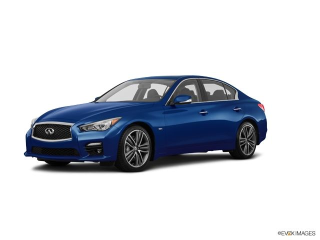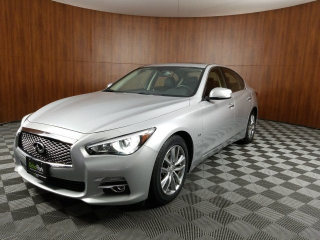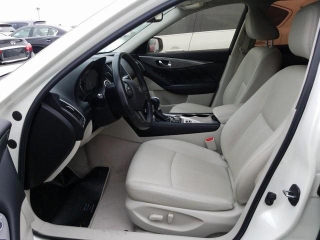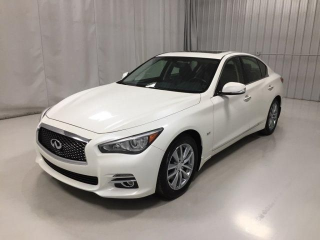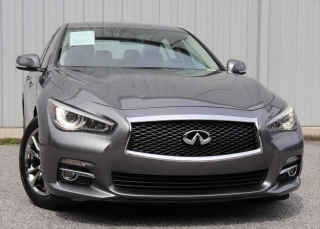The 2017 Infiniti Q50 is a mid-cycle refresh of Infiniti's luxury compact sports sedan, first introduced for the 2014 model year. Replacing the G37, it offered a sleek, athletic body style. Key trims included the 2.0t, 3.0t, and Red Sport 400, alongside Hybrid variants. New pricing ranged from approximately $34,000 to over $50,000. It stands out for its bold styling, upscale interior, and powerful new twin-turbo V6 engines, offering compelling performance for its class.
The Good
The 2017 Q50 boasts strong performance, especially with its new twin-turbo V6 engines, delivering exhilarating acceleration for emotional buyers. Its distinctive, luxurious design and comfortable interior appeal to those seeking style. For practical buyers, it offers competitive value in the luxury segment and decent fuel efficiency, particularly the 2.0t and Hybrid models.
The Bad
Watch out for the polarizing Direct Adaptive Steering (DAS) system, which lacks tactile feedback. The dual-screen infotainment system can be clunky and outdated. Some owners report firm ride quality, especially with larger wheels, and there have been concerns regarding turbocharger issues on the new V6 engines and electrical quirks.
2017 Infiniti Q50: Quick Overview
- Engine Options:
- 2.0-liter Turbocharged I4: 2.0t, 2.0t Premium
- 3.0-liter Twin-Turbo V6: 3.0t Premium, 3.0t Sport, Red Sport 400
- 3.5-liter V6 Hybrid: Hybrid Premium, Hybrid Sport
- Horsepower:
- 2.0t I4: 208 hp
- 3.0t V6: 300 hp
- Red Sport 400 V6: 400 hp
- Hybrid: 360 hp (combined)
- Fuel Economy (EPA Estimated MPG City/Highway):
- 2.0t RWD: 23/31 mpg
- 2.0t AWD: 22/28 mpg
- 3.0t RWD: 20/29 mpg
- 3.0t AWD: 19/27 mpg
- Red Sport 400 RWD: 20/27 mpg
- Red Sport 400 AWD: 19/26 mpg
- Hybrid RWD: 27/32 mpg
- Hybrid AWD: 27/31 mpg
- 0-60 MPH Times (Approximate):
- 2.0t: 7.1 seconds
- 3.0t: 5.2 seconds
- Red Sport 400: 4.5 seconds
- Hybrid: 4.9 seconds
- Towing Capacity: Not recommended or rated for towing.
- Trim-Level Features:
- 2.0t: Standard LED headlights, 17-inch wheels, dual-zone automatic climate control, Infiniti InTouch dual-display infotainment system, rearview camera, keyless ignition.
- 2.0t Premium: Adds moonroof, upgraded audio, heated front seats, heated steering wheel.
- 3.0t Premium: Similar to 2.0t Premium but with 300hp V6 engine, 18-inch wheels.
- 3.0t Sport: Adds sport-tuned suspension, larger brakes, unique 19-inch wheels, leather-appointed sport seats, aluminum trim.
- Red Sport 400: High-performance variant with 400hp V6, even more aggressive sport suspension, performance brakes, unique 19-inch staggered wheels, and exclusive exterior/interior accents.
- Hybrid Premium/Sport: Shares features with their gasoline counterparts but with the hybrid powertrain.
2017 Infiniti Q50 Specifications
Vehicle Information
| Year | 2017 |
| Make | Infiniti |
| Model | Q50 |
| Trim | - |
| Style | 4-Door Sedan 3.0-T |
| Type | Sedan |
| Category | Mid-Size Car |
Manufacturing Details
| Made In | Japan |
| Manufacturing City | TOCHIGI PLANT, KAWACHI-GUN |
Dimensions
| Doors | 4-Door |
| Curb Weight | 1734.54 kg |
| Gross Vehicle Weight Rating | - |
| Overall Height | 145.29 cm |
| Overall Length | 478.28 cm |
| Overall Width | 182.37 cm |
| Wheelbase Length | 284.99 cm |
| Standard Seating | 5 |
Engine & Performance
| Engine | 3.0-L |
| Engine Size | 3L |
| Engine Cylinders | 6 |
| Transmission | 7-Speed Automatic |
| Transmission Type | Automatic |
| Transmission Speeds | 7-Speed |
| Drivetrain | All-Wheel Drive |
Additional Features
| Anti-Brake System | 4-Wheel ABS |
| Steering Type | Rack & Pinion |
Pricing
| Manufacturer Suggested Retail Price (MSRP) | $40,400 USD |
| Invoice Price | $37,572 USD |
| Delivery Charges | $905 USD |
Vehicle History Report
Vehicle
Specifications
Specifications
Ownership
History
History
All History
Events
Events
NMVTIS Title
History Check
History Check
Salvage/Rebuilt
Check
Check
Accident
Check
Check
Theft
Check
Check
Open Lien
Check
Check
Past Sale
Listings
Listings
Safety
Recalls
Recalls
Odometer
Check
Check
Market Price
Analysis
Analysis
What Problems Does the 2017 Infiniti Q50 Have?
The 2017 Infiniti Q50, while generally reliable, has several frequently reported problems and areas of concern. A significant issue revolves around the 3.0-liter twin-turbo VR30DDTT engine, particularly regarding turbocharger failures. Owners have reported "limp mode" activation, reduced power, and eventually requiring turbo replacement, often due to issues with the wastegate actuators or the turbos themselves. This is a costly repair. Infiniti has issued technical service bulletins (TSBs) related to this, but it remains a common complaint.
Another recurring problem involves the Direct Adaptive Steering (DAS) system, an optional steer-by-wire technology. While innovative, some owners report occasional malfunctions, including system warnings or a sudden change in steering feel, which can be unsettling. Software updates have been released, but reliability concerns persist for some.
The InTouch dual-screen infotainment system, while visually appealing, has been criticized for slow response times, occasional glitches, and a somewhat convoluted menu structure, leading to frustration for users. Bluetooth connectivity issues have also been reported.
Electrically, some owners have experienced minor annoyances such as flickering dashboard lights, issues with power windows, or sensor malfunctions. Rattles and squeaks from the interior, particularly around the dashboard or panoramic sunroof, are also noted by some.
Regarding recalls, the 2017 Q50 had a few. One notable recall involved the direct adaptive steering system, where a software issue could lead to a loss of steering control in specific rare circumstances. Another recall addressed a potential fuel pressure sensor issue which could lead to an engine stall. Owners should always verify that all applicable recalls have been addressed by checking with an Infiniti dealership or the NHTSA website for their specific VIN. Long-term reliability is generally good for the naturally aspirated and hybrid powertrains, but the VR30DDTT's turbocharger issues are a primary long-term reliability concern for those specific models.
Another recurring problem involves the Direct Adaptive Steering (DAS) system, an optional steer-by-wire technology. While innovative, some owners report occasional malfunctions, including system warnings or a sudden change in steering feel, which can be unsettling. Software updates have been released, but reliability concerns persist for some.
The InTouch dual-screen infotainment system, while visually appealing, has been criticized for slow response times, occasional glitches, and a somewhat convoluted menu structure, leading to frustration for users. Bluetooth connectivity issues have also been reported.
Electrically, some owners have experienced minor annoyances such as flickering dashboard lights, issues with power windows, or sensor malfunctions. Rattles and squeaks from the interior, particularly around the dashboard or panoramic sunroof, are also noted by some.
Regarding recalls, the 2017 Q50 had a few. One notable recall involved the direct adaptive steering system, where a software issue could lead to a loss of steering control in specific rare circumstances. Another recall addressed a potential fuel pressure sensor issue which could lead to an engine stall. Owners should always verify that all applicable recalls have been addressed by checking with an Infiniti dealership or the NHTSA website for their specific VIN. Long-term reliability is generally good for the naturally aspirated and hybrid powertrains, but the VR30DDTT's turbocharger issues are a primary long-term reliability concern for those specific models.
How long will the 2017 Infiniti Q50 last?
A well-maintained 2017 Infiniti Q50 can typically achieve 150,000 to 200,000 miles or more, translating to 12-15+ years of service with average driving habits. Owner data suggests that consistent oil changes, fluid flushes, and addressing known issues proactively are crucial. Long-term durability is generally strong for the chassis and non-turbo components. However, the VR30DDTT twin-turbo V6 engines, especially in the 3.0t and Red Sport 400 trims, are susceptible to turbocharger failures, which can be a significant and expensive weakness over time if not addressed. The Direct Adaptive Steering (DAS) system can also present long-term reliability questions due to its complexity. Regular maintenance is paramount for maximizing its lifespan and mitigating potential high-cost repairs.
What Technology & Safety Features are Included?
The 2017 Infiniti Q50 features a distinct built-in technology suite centered around its InTouch dual-display infotainment system. This setup consists of an 8-inch upper screen for navigation and vehicle information, and a 7-inch lower touchscreen for climate control and entertainment functions. Standard entertainment includes a six-speaker audio system, HD Radio, satellite radio, two USB ports, and Bluetooth connectivity. Optional upgrades include a Bose 15-speaker premium audio system and a navigation system with voice recognition. While functional, the dual-screen interface has been criticized for its sometimes slow response and menu complexity, feeling a bit dated compared to rivals.
Driver-assistance features were quite comprehensive for its time, many available as part of optional packages. These included the highly debated Direct Adaptive Steering (DAS) system, Intelligent Cruise Control, Lane Departure Warning and Prevention, Blind Spot Warning and Intervention, Forward Emergency Braking, Back-up Collision Intervention, and Around View Monitor (360-degree camera system).
Standard safety features included a comprehensive airbag system (front, side-impact, side curtain), anti-lock brakes (ABS), stability control, traction control, and a rearview camera. Optional safety enhancements like predictive forward collision warning and pedestrian detection further bolstered its protective capabilities.
As for crash-test ratings, the 2017 Infiniti Q50 received strong scores. The National Highway Traffic Safety Administration (NHTSA) gave the Q50 a perfect 5-star overall safety rating. The Insurance Institute for Highway Safety (IIHS) awarded the Q50 "Good" ratings in most crashworthiness tests, including moderate overlap front, side, roof strength, and head restraints & seats. However, its front crash prevention system received a "Superior" rating when equipped, while headlight ratings varied depending on the specific trim and optional lighting packages.
Driver-assistance features were quite comprehensive for its time, many available as part of optional packages. These included the highly debated Direct Adaptive Steering (DAS) system, Intelligent Cruise Control, Lane Departure Warning and Prevention, Blind Spot Warning and Intervention, Forward Emergency Braking, Back-up Collision Intervention, and Around View Monitor (360-degree camera system).
Standard safety features included a comprehensive airbag system (front, side-impact, side curtain), anti-lock brakes (ABS), stability control, traction control, and a rearview camera. Optional safety enhancements like predictive forward collision warning and pedestrian detection further bolstered its protective capabilities.
As for crash-test ratings, the 2017 Infiniti Q50 received strong scores. The National Highway Traffic Safety Administration (NHTSA) gave the Q50 a perfect 5-star overall safety rating. The Insurance Institute for Highway Safety (IIHS) awarded the Q50 "Good" ratings in most crashworthiness tests, including moderate overlap front, side, roof strength, and head restraints & seats. However, its front crash prevention system received a "Superior" rating when equipped, while headlight ratings varied depending on the specific trim and optional lighting packages.
What Colors Options are Available?
2017 Infiniti Q50 Prices and Market Value
When new, the 2017 Infiniti Q50 had a wide price range. The base 2.0t started around $34,000, while the 3.0t models ranged from approximately $39,000 to $48,000, and the top-tier Red Sport 400 could exceed $50,000, before options. Hybrid models were also in the higher end of the spectrum.
In the current used market (late 2023/early 2024), prices for a 2017 Q50 can range from roughly $15,000 for higher-mileage 2.0t models to over $25,000 for well-maintained Red Sport 400 or lower-mileage 3.0t Sport trims. Depreciation has been significant, typical for luxury sedans. Factors affecting resale value include mileage, condition, optional packages (especially driver-assistance and performance upgrades), and whether a vehicle has experienced known issues like turbocharger failures. The V6 models, particularly the Red Sport 400, tend to hold their value slightly better due to desirability, but generally, the Q50 depreciates faster than some key German rivals.
In the current used market (late 2023/early 2024), prices for a 2017 Q50 can range from roughly $15,000 for higher-mileage 2.0t models to over $25,000 for well-maintained Red Sport 400 or lower-mileage 3.0t Sport trims. Depreciation has been significant, typical for luxury sedans. Factors affecting resale value include mileage, condition, optional packages (especially driver-assistance and performance upgrades), and whether a vehicle has experienced known issues like turbocharger failures. The V6 models, particularly the Red Sport 400, tend to hold their value slightly better due to desirability, but generally, the Q50 depreciates faster than some key German rivals.
2017 Infiniti Q50 Cost of Ownership
The 2017 Infiniti Q50 is generally considered moderately costly to own for a luxury compact sedan. Insurance costs are typical for its class, varying by engine (higher for Red Sport 400) and driver profile. Fuel costs are moderate; while the 2.0t is efficient, the twin-turbo V6s prefer premium fuel and consume more. Maintenance costs are higher than average sedans but competitive for a luxury brand. Routine service can be performed at Infiniti dealerships or independent shops. Repair costs can be significant, especially if major components like the twin-turbochargers fail. Overall, while not outrageously expensive, it's not economical; potential owners should budget for premium fuel and potentially higher repair bills, particularly for VR30DDTT models.
2017 Infiniti Q50 Fuel Efficiency
Fuel Type
Gasoline
Fuel Capacity
41.26 liters
City Mileage
5.36 km/l
Highway Mileage
3.74 km/l
2017 Infiniti Q50 Safety Rating
NHTSA
2017 Infiniti Q50 Warranty
Basic
Original warranty
48 months / 60,000 miles
Estimated remaining
Expired
Powertrain
Original warranty
72 months / 70,000 miles
Estimated remaining
Expired
Rust
Original warranty
84 months / unlimited miles
Estimated remaining
Expired
2017 Infiniti Q50 Insurance
Insurance for a 2017 Infiniti Q50 is moderately priced, reflecting its status as a Sedan with strong safety ratings and
reasonable repair costs.
reasonable repair costs.
How Does the 2017 Infiniti Q50 Compare to Other Sedan?
The 2017 Infiniti Q50 competes directly with established players like the BMW 3 Series, Mercedes-Benz C-Class, Audi A4, and Lexus IS. In terms of performance, the Q50 truly stands out, particularly with its new 3.0t (300hp) and Red Sport 400 (400hp) twin-turbo V6 engines. These engines often outmuscle similarly priced rivals, offering more horsepower than base and mid-range German competitors like the BMW 330i or Mercedes C300, and even challenging performance-oriented models like the BMW 340i. However, its handling, especially with the Direct Adaptive Steering, can feel less engaging and precise than a BMW 3 Series.
When it comes to features, the Q50 offers a generous list for its price point, with standard LED lighting and a dual-screen infotainment system. However, its infotainment system, while unique, is often criticized for being less intuitive and slower than Audi's MMI or Mercedes' COMAND. Interior material quality is good, but doesn't quite match the premium feel of a C-Class or the tech-forward cabin of an A4. Driver-assistance features are robust but often optional.
Reliability is a mixed bag. While Lexus IS is generally considered segment-leading for reliability, and the German rivals are typically solid, the 2017 Q50's VR30DDTT engine has known issues with turbocharger longevity, which tarnishes its reputation compared to its competitors. Models with the 2.0t or Hybrid powertrains tend to be more reliable.
Regarding price, the Q50 typically offered more power and features for less money than its German and Japanese luxury rivals when new. This makes it an attractive used purchase from a value perspective. However, the potential for expensive turbo-related repairs should be factored into the overall cost.
Alternatives:
The Q50 is a strong contender for those prioritizing raw power and bold styling at a competitive price, but rivals offer better driving dynamics, interior refinement, or proven reliability in specific areas.
When it comes to features, the Q50 offers a generous list for its price point, with standard LED lighting and a dual-screen infotainment system. However, its infotainment system, while unique, is often criticized for being less intuitive and slower than Audi's MMI or Mercedes' COMAND. Interior material quality is good, but doesn't quite match the premium feel of a C-Class or the tech-forward cabin of an A4. Driver-assistance features are robust but often optional.
Reliability is a mixed bag. While Lexus IS is generally considered segment-leading for reliability, and the German rivals are typically solid, the 2017 Q50's VR30DDTT engine has known issues with turbocharger longevity, which tarnishes its reputation compared to its competitors. Models with the 2.0t or Hybrid powertrains tend to be more reliable.
Regarding price, the Q50 typically offered more power and features for less money than its German and Japanese luxury rivals when new. This makes it an attractive used purchase from a value perspective. However, the potential for expensive turbo-related repairs should be factored into the overall cost.
Alternatives:
- BMW 3 Series (F30): Better handling dynamics, more engaging driving experience.
- Mercedes-Benz C-Class (W205): Superior interior luxury, more refined ride.
- Audi A4 (B9): Excellent technology interface, sophisticated AWD system.
- Lexus IS: Best-in-class reliability, smooth powertrain (especially the V6).
The Q50 is a strong contender for those prioritizing raw power and bold styling at a competitive price, but rivals offer better driving dynamics, interior refinement, or proven reliability in specific areas.
Final Verdict: Is the 2017 Infiniti Q50 a Good Sedan?
The 2017 Infiniti Q50 is ideal for buyers seeking a powerful, stylish luxury sports sedan with a distinctive look that offers strong performance for the money. It appeals to those who prioritize acceleration and a comfortable, well-appointed cabin over ultimate handling precision or cutting-edge infotainment. It's particularly suited for someone who wants to stand out from the common German luxury crowd.
As a used purchase, the 2017 Q50 can be a worthwhile buy, especially considering its significant depreciation. However, it comes with caveats. If purchasing a 3.0t or Red Sport 400 model, thoroughly investigate its service history for turbocharger issues and ideally get a pre-purchase inspection from an Infiniti specialist. The 2.0t and Hybrid trims offer better long-term reliability prospects, making them safer used buys. It's not recommended for those prioritizing a highly intuitive infotainment system or the most engaging driving dynamics. But for performance-per-dollar in a luxurious package, it remains a compelling choice, provided one is aware of and prepared for its potential mechanical quirks.
As a used purchase, the 2017 Q50 can be a worthwhile buy, especially considering its significant depreciation. However, it comes with caveats. If purchasing a 3.0t or Red Sport 400 model, thoroughly investigate its service history for turbocharger issues and ideally get a pre-purchase inspection from an Infiniti specialist. The 2.0t and Hybrid trims offer better long-term reliability prospects, making them safer used buys. It's not recommended for those prioritizing a highly intuitive infotainment system or the most engaging driving dynamics. But for performance-per-dollar in a luxurious package, it remains a compelling choice, provided one is aware of and prepared for its potential mechanical quirks.
